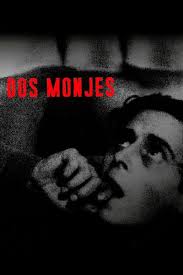
At a monastery in Mexico, Brother Javier (Carlos Villatoro) is acting as if he is possessed by Satan. He experiences periods of violent ranting, followed by periods of calm. The Prior (Beltran de Heredia) hopes that the new friar can bring some sanity back to Brother Javier. The new monk, Brother Servando (Victor Urruchua), is sent to Javier’s cell. The Prior hopes that Servando’s calm and ardent faith will work to expel the demons from Javier’s soul. As soon as Javier sees the new monk, he threatens to hit him with a stool. Servando leaves Javier’s cell. Javier follows him and confronts the new monk calling him Juan. Being addressed as Juan, Servando then recognizes Javier. Javier picks up a large crucifix, hits Servando over the head and retreats back to his cell.
When the Prior asks Javier why he attacked Brother Servando Javier tells him that years ago he knew the Monk as Juan. Javier and Juan grew up together and were best friends. Juan was an adventurer and was away most of the time. Javier was a composer and was very sickly. He lived with his mother, Gertrudis (Emma Roldan). Across the road from Javier was a young woman named Ana (Magda Haller). Javier was in love with Ana and wrote a song for her. When Ana’s guardians tried to pimp her out to a rich man she refused and scratched him. The guardians then throw Ana out into the street. Javier and his mother take her in. Eventually Javier proposes to Ana.
Not long after that, Juan returns. When he meets Ana, he too falls in love with her. One day, Javier returns home to find Juan forcing his attention on Ana. The ensuing argument results in Ana’s death. When the Prior talks to Juan about Javier’s story his version is markedly different.
“Two Monks” AKA “Dos monjes” was released in 1934 and was directed by Juan Bustillo Oro. It is a Mexican drama. Although the movie was advertised as a horror story it is actually a melodrama. A rather tedious one.
However, there are some good things about the movie. The cinematography is excellent, and the film has had an extensive restoration that is wonderful. There are lots of touches that are reminiscent of German Expressionism, which add a lot of character to the film.
The movie is often compared to the Rashomon style of storytelling where different versions of an event are told, and the truth is somewhere in the middle. The Rashomon effect is slightly twisted in that the two stories are markedly different but the images on screen are similar in their conclusion. In Javier’s version he says that Juan accidentally killed Ana. In Juan’s version he says that Javier was the one who accidentally shot Ana. However, in the corresponding film footage of Juan’s story he is seen shooting Ana and not Javier. The incongruity is continued in that in Javier’s story he is wearing white, and Juan is wearing black. That image is reversed in Juan’s story where Javier is wearing black, and Juan is the one wearing white. The ending of the two stories is confusing, unless the images reveal the truth, and the words are the lie. Then they would make sense.
All of these pluses make the film an outstanding, thought-provoking drama and even perhaps a masterpiece for director Juan Bustillo Oro, but a boring horror movie.

